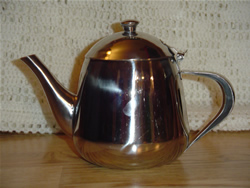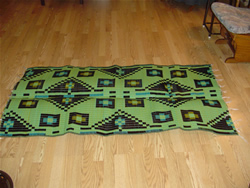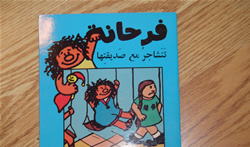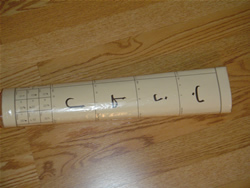Box #1: Culture in Migration
Description of Artifacts
Senegalese Eating Bowls
 Bowls are used for meals where those eating sit on Senegalese eating mat around the bowl using their hands to eat from their portion of the bowl. Below are eating around the bowl Do’s and Don’ts.
Bowls are used for meals where those eating sit on Senegalese eating mat around the bowl using their hands to eat from their portion of the bowl. Below are eating around the bowl Do’s and Don’ts.
Senegalese Tea Cups

These cups are used for social tea drinking for house visitors and/or after meals. A sitting of tea includes three rounds of tea, each less potent, but more sugary than the last. These rounds of tea can take many hours which lead to the opportunity for conversation. Etiquette during tea time also calls for froth on the top of the tea and mint leaves for flavor to be added. Often times tea drinkers will share glasses due to lack of money to purchase a large set of glasses
Senegalese Tea Kettle

These tea kettles are usually heated over portable propane canisters that are used for all cooking throughout daily life. Tea kettles are utilized to make tea for social visits and after meals. This particular tea kettle is slightly more expensive and higher quality than some others that may be seen in everyday life due to the fact that it’s nickel and rust-proof.
Directions for tea:
- Heat water
- Add Chinese gun powder tea
- Add sugar
- Add mint leaves
- Pour high over each cup to create “froth” in tea cups (optional)
Senegalese Eating Mat

Used in daily life for meals. One or more may be used for the entire family. It is placed on the floor with the food in a bowl placed in the center. Shoes are not to be worn on the mat women are to dress modestly at meals and elders eat first. Dining rooms and furniture are not common. It is common for homes to have one main room for many activities, therefore the mat is used to set the room for meals.
Arabic Alphabet Poster
This poster details the Arabic alphabet characters and how they appear in the beginning, middle, and end of a word. In addition the phonemic sounds are represented. Numbers are located along the bottom.
Arabic is the language of Islam which is practiced by 90-95% of the Senegalese population. Informal Islamic street schools are commonly located in neighborhoods and villages in which the pronouncing and reading of these letters is taught with Qu’ranic writing boards.
Map of Africa
This map details the countries, country capitals and waterways of the continent of Africa . Along with the flags of the African nations, time zones, and climate graphs of some nations including Senegal . Africa is a continent of great size and a wide variety of cultures and landscapes Senegal is just one piece of a larger picture. This must be included in any discussion of its culture. Senegal is located on the West Coast of Africa.
Arabic Picture Book

This book is written in Arabic script and is about two young girls who are best friends and whose moms are also best friends. In the middle of the story there is a disagreement, and in the end they make up. Since Arabic is written and read right to left the book begins and opens from the opposite end that English books are opened.
Mon premier Dictionaire Francias-Anglias Tout en Arebe(My First French-English and Arabic Alphabet book): By Hassan Musa
Many children in Senegal learn to read and write Arabic in Qu’ranic Street schools. This book uses the English Alphabet as a frame. For each letter an animal is drawn with Arabic characters and the name of the animal is translated from English to Arabic and French.
Jekker Ju Amulub Leget: Maam Daawur Wadd Wolof Picture Book

This is a Wolof story that has been put into print by a Senegalese storyteller, Maam Daawar Wadd. Wolof is one of the six national languages of Senegal . It is spoken by most Senegalese regardless of ethnicity (Wolof, Serer, Pulaar, Fulani, Mandinke’,,Soninke’, Diolla [Jollah]). Because it is not the official language (French),and Colonial influence is dominant in print and other types of media, it is quite a success to get this book published in Wolof a language more of the people
Jabu Ndaw by: Maam Daawur Wadd Wolof Picture Book

This is a Wolof story that has been put into print by a Senegalese storyteller, Maam Daawar Wadd. Wolof is one of the six national languages of Senegal . It is spoken by most Senegalese regardless of ethnicity (Wolof, Serer, Pulaar, Fulani, Mandinke’,,Soninke’, Diolla [Jollah]). Because it is not the official language (French),and Colonial influence is dominant in print and other types of media, it is quite a success to get this book published in Wolof a language more of the people
La belle Histoire de Leuk Le lievre: Cours Elementaire des ecdes d’ Afrique Noire By L. Senghor and A.Sadji
This Anthology was co-written by the famous poet and first post-colonial Senegalese president Liepold Senghor. It is written in French and is often used as a elementary language training text book for 3 rd and 4 th grade. It is culturally relevant because of the mention of Leuk(Wolof: Lekk, the trickster rabbit, as well as Bouki, the fool hyena. In the folktales of the Senegambia (Senegal/Gambia) region the rabbit historically plays the role of the trickster, and the Hyena, the role of the “tricked”. Many slaves (60%) were forcefully removed from this very area and brought to Louisianna. Because the rabbit and the wolf appear in so many American tales as the trickster (The Turtle and the Hare) and the fool (Little Red Riding Hood) This poses as a connection between Africa, African Diaspora, and American popular culture .
Little Red Riding Hood: Published by Book Club of America
This book was not purchased Senegal but instead in Michigan . The story is culturally relevant because it is an example of the cultural connections between Africa , African Diaspora, and American Popular Culture. Bouki the hyena historically, in the Senegambia (Senegal/Gambia) region, plays the role of the fool. Many slaves (60%) were forcefully removed from this very area and brought to Louisianna. Because the wolf (hyena) appears in so many American tales as the fool (Little Red Riding Hood) this poses as a connection between Africa , African Diaspora, and American popular culture.
Post Cards
- Each post cards is labeled with a number that refers to the artifact that it accompanies.
- If a card has a number and a letter this indicates there is more than one post card that applies to the same artifact.
- If the post card number is (13) there are written questions or comments, rather than artifacts, that accompany the post card.

